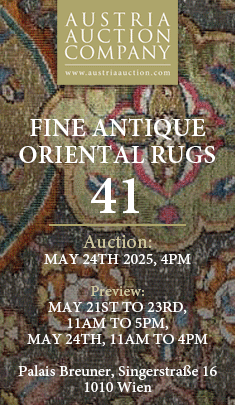The Thyssen Mughal Hunting Carpet at Sotheby’s
This mid-17th century North Indian Mughal carpet, until recently furnishing the Swiss home of the late Baron Heinrich Thyssen-Bornemisza, sold at Sotheby’s in New Bond Street, London, on 3 July 2013 (lot 23) for £314,500 ($481,185), approximately three times its lower estimate.

The field design is fairly standard for a Mughal ‘hunting’ carpet. A single pattern unit displaying a lion attacking a humped bull and three other large spotted or striped felines attaching smaller quadrupeds fills the red ground from side to side. Between these creatures one finds an arabesque arrangement of the large palmettes, lanceolate leaves and smaller leaves, buds, blossoms and vines so typical of most North Indian carpet design, complete with racemes and a great deal of ton-sur-ton colouring. This single design is repeated four times along the length of the carpet, alternately reversed after each repeat. So far, this is standard Mughal design and although naively attractive, many of the same figures similarly arranged can be found on dozens of other examples, many more skilfully designed and executed. As for structure, the off-white cotton warps are multi-stranded Z6-7S, with three passes of unbleached cotton weft, and the knot count of 15-17 V x 8-9 H per 10cm, is exactly as one would expect. But the beauty and rarity of lot 23 is its major border, one of the best presently known. Against a dark blue ground, the standard Mughal border of a meandering stem enclosing inward and outward facing large palmettes has been greatly refined and elaborated. The stem itself more closely resembles European mannerist strap-work. Some of the large palmettes have been replaced by additional animal combats, and the corner resolutions are exceptionally elegant and successful. These features obviously increase the value of the carpet even though it is significantly damaged. A continuous fold or tear runs through the vertical centre of the carpet, from top to bottom. Most of the damaged area has been re-warped and re-pilled and although the dramatic borders are still in very good condition, much of the central field is low with some additional re-piling.
Considering its condition, such a high price for any similar Mughal carpet would have been inconceivable a year ago, but the present state of the market in historic carpets with good provenance has changed dramatically in recent months. Since the collapse of most Western economies in 2007/8, less than perfect classical-period carpets have seen their prices hold firm relative to the fall in value of large, decorative 19th century carpets in good condition. Until very recently those 19th century Heriz, Amritsar and Agra carpets were attracting sales higher per unit of measurement than their visually similar 17th century Esfahans and North Indian equivalents.
Beginning in about 2009, a succession of auctions in London and New York, culminating in The Clark sale at Sotheby’s New York on 5 June 2013, seems to have emphatically changed that situation. Though some examples from the Clark auction were truly rare, beautiful and undoubtedly worth the money, others without the Clark/Corcoran provenance might ordinarily have been expected to sell for much less. Having remained in an American collection and then in a museum for a century, there would have been no export difficulties with regard to the current American ban on Iranian goods, regardless of the nationality of the purchaser. It seems that in addition to those known buyers from the Gulf whose wealth has actually increased since the economic collapse, new players (American?, Russian?) have entered the field, purchasers who might be forming new collections and others who have not previously been considered serious carpet collectors. Who ever these new collectors might be, first the provenance of the Clark collection, and now a sudden apparent appreciation of the relative rarity of historic carpets, whether in perfect or less than perfect condition seems to have motivated them to offer large sums to acquire pieces such as this former Yerkes/Remarque/Thyssen example.
![Lot-23,-Mughal-hunting-carpet[1]-crop](https://hali.com/wp-content/uploads/2013/07/Lot-23-Mughal-hunting-carpet1-crop.jpg)














